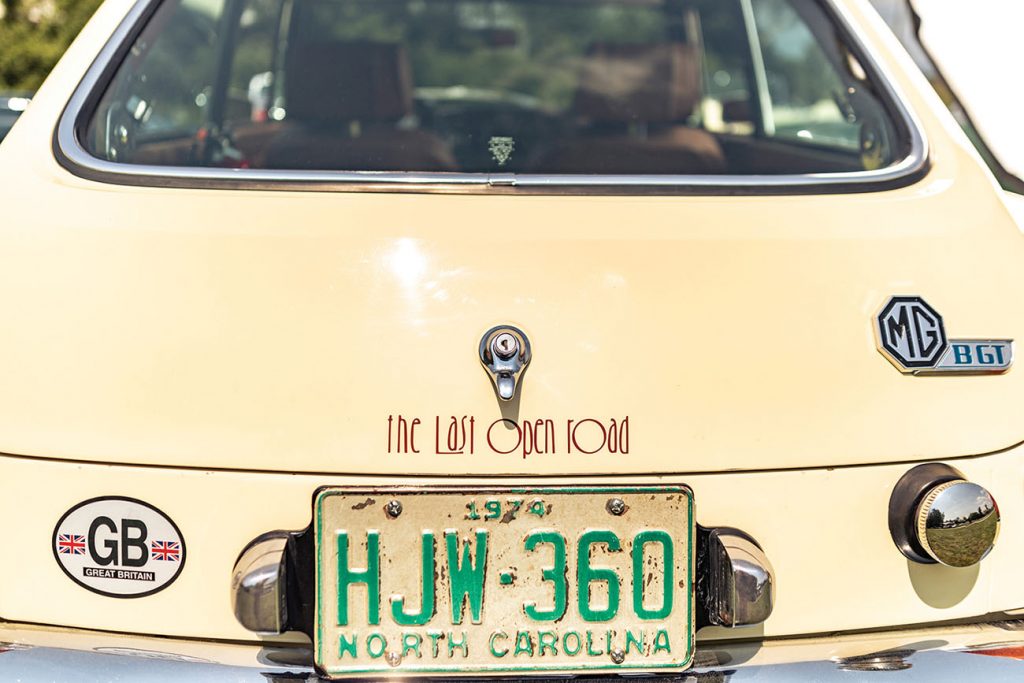
Photo by Rimas Zailskas
If they were good enough for James Bond, they are good enough for the British Car Club of Western North Carolina. This local crew can be seen cruising the Blue Ridge Parkway in Triumph convertibles, Lotus coupes and Jaguar sedans.
Of course, their British cars don’t have rocket launchers or smoke screens, like those driven by 007. And contrary to what one might assume, the club members didn’t fall in love with cars from England because they wanted to be one of the Queen’s secret agents.
David Adams purchased his 1960 Triumph TR3 in 1971 because he needed an inexpensive car to drive to his summer job between grad school semesters. “Two good friends of mine thought it was the coolest car in the world, but I didn’t even know what one looked like,” he says. “More important was that at $400 it fit my budget.”
Adams and his father spent six weeks working on the jalopy before they got it to run well. At the end of the summer, he tried unsuccessfully to sell the troublesome vehicle. It sat in his grandmother’s garage until the next summer, when he again came home to work. “After that I became attached to it, and I’ve owned it ever since,” he says.
Other members have similar stories about cash-strapped purchases in their early years. Many of them have been members of the British Car Club even since, but often in chapters scattered across the United States.

Back Row, L-R: Gene Carter, Mark Faruer, Anthony Auey, Matthew Camp. Front Row, L-R: Carole Carter, June Judson, Jill Meyer, Derek Cook, Alvan Judson.
Rimas Zailskas
One theory traces the American fascination to World War II, when soldiers fell in love with the small, sporty convertibles and brought them back home. Years later, they might have passed the cars on to their Baby Boomer children. By then, the cars like the Triumph and MGB also would have been old enough to pick up on the cheap.
Bond’s favored Aston Martins and Bentleys, on the other hand, have been out of reach for all but the wealthiest drivers, then and now.
Ironically, as vintage British cars have become more rare, the availability of parts has improved, said Bennett French, club president and owner of Standard Performance, a British parts and service company. “It’s easier now than it was 25 or 30 years ago,” he says. “You can practically build a new car.”
That’s important, considering that many enthusiasts love models from the 1960s and 70s that typically need a little — or a lot — of work.
George deWalder recalled his first 1967 MGB, a “rust bucket” that required heaps of time and money. “My wife confronted me with our one-year-old daughter and said ‘It’s either the car or us,'” he says.
He chose his young family at the time, but years later, when he and his wife separated, he went right out and bought a 1975 MGB. He now has it completely refurbished and takes it out to shows, club rides and rallies.
Many of these cars only see the light of day on those special occasions. deWalder and others certainly don’t take them out in the rain or snow, because they want to preserve the paint job…and because old British convertibles are famous for leaking. Some of these British cars have their share of mechanical quirks, too, as deWalder and his girlfriend discovered during a rally in 2001.

Cover illustration by James Flames.
A rally is a driving event in which a driver and a navigator set out to follow directions from start to finish. The fastest car doesn’t win, but rather the one with the most accurate time, average speed and distance for the route.
deWalder and his girlfriend were rallying across the Piedmont countryside near Winston-Salem. Unfortunately, they had missed a turn and were unknowingly heading far off course when they smelled something burning.
The car came to a stop, as a result of a fuel pump wire that inadvertently touched a part of the metal frame and burned out. Stranded with no cell phone signal, they walked to the nearest landline and called a tow truck. Unfortunately, deWalder needed a flatbed, which was not the first wrecker to show up. (Towing a small convertible on its front wheels can cause considerable damage when the light cars bump around.) They had to wait a few more hours, and the sun was going down when they finally had their ride.
To his credit, deWalder made up for the mishap several years later with a first place win in the local rally.
Lest one should think this is a guy’s club where the women simply ride along, consider Carole Carter, who was president of the club for the past two years. She and her husband own a 1964 Lotus Elan, which they take turns driving. When her husband organized the last rally, she and another female club member drove together and took second place. “It’s fun to drive with the top down and the gorgeous mountains,” she says. “What could be better?”

